
Photo from wikipedia
Venous thromboembolism represents a significant clinical and socioeconomic burden. Surgical patients are an inherently high-risk cohort for VTE although traditional prophylactic pharmacological therapies are contraindicated in select cohorts. Novel physical therapies… Click to show full abstract
Venous thromboembolism represents a significant clinical and socioeconomic burden. Surgical patients are an inherently high-risk cohort for VTE although traditional prophylactic pharmacological therapies are contraindicated in select cohorts. Novel physical therapies such as calf exercises and electrostimulation have been proposed for such patients. The aim of this systematic review is to appraise the clinical utility of novel physical therapies used for DVT prophylaxis in surgical and trauma patients. A systematic review of MEDLINE, EMBASE and CINAHL using a PRISMA-compliant methodology up to July 2019 was conducted. Abstract screening and data extraction were performed in duplicate. Risk of bias and quality assessments were performed for each study using the GRADE framework. A total of 272 articles were identified, of which 10 met inclusion criteria. Five studies evaluated the use of calf electrostimulation, the remaining studies evaluated active toe movement, bespoke compression bandages, blood flow restriction exercises, calf massage and a portable compression device. Four randomized controlled trials demonstrated a significant reduction in radiological DVT incidence with electrostimulation, post-operative massage and pneumatic compression versus controls. All included studies had a moderate to high risk of bias. The role of physical therapies as prophylactic measures in VTE remain equivocal. No study demonstrated a significant reduction in clinically evident DVT. The physical therapies can be beneficial in patients who also received pharmacological therapy, whilst physical therapies alone may be of no benefit. Heterogenous study design and poor methodological quality limit comparison of study findings at present. Physical therapies as prophylactic measures in venous thromboembolism may offer benefit when combined with pharmacotherapy. When used alone, physical therapies may offer no benefit.
Journal Title: British Journal of Surgery
Year Published: 2021
Link to full text (if available)
Share on Social Media: Sign Up to like & get
recommendations!